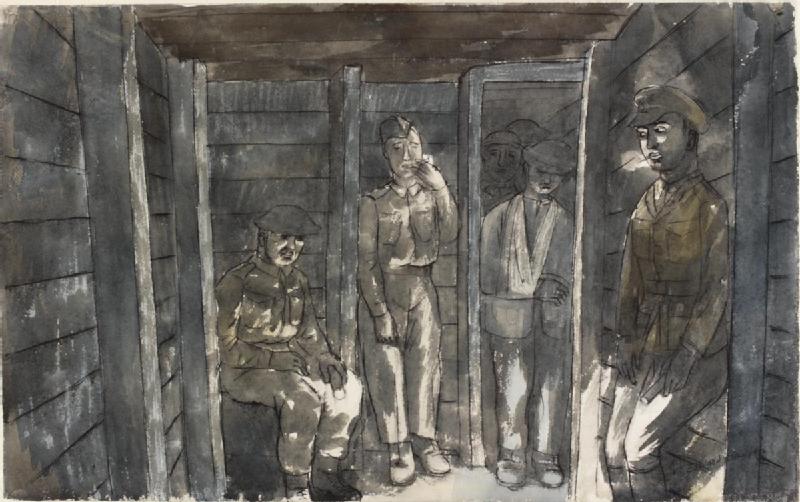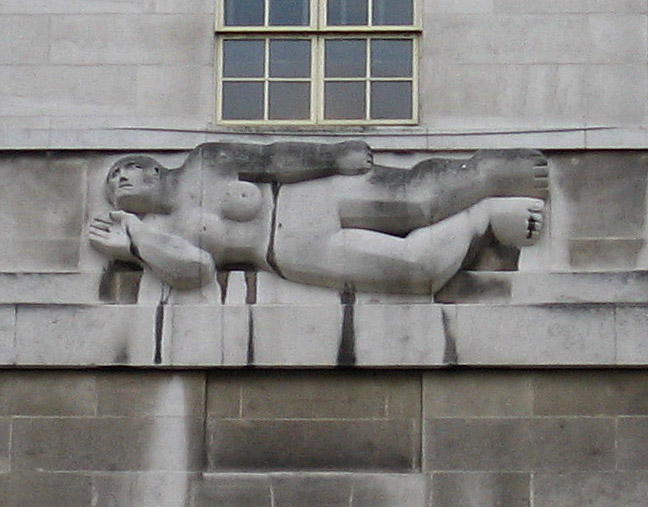|
Percy Horton
Percy Frederick Horton MA, RBA, ARCA (8 March 1897 in Brighton, England – 1970) was an English painter and art teacher, and Ruskin Master of Drawing, University of Oxford from 1949 to 1964. During the First World War he was imprisoned as a conscientious objector. Early life Horton was one of three brothers born into a working-class family in Brighton; his father, Percy Horton, was a bus conductor and his mother, Ellen (née Marman), had worked in service and as a nurse. His younger brother was artist Ronald Horton (1902–1981).Ronald Horton National Archives; retrieved 21 May 2011 Horton's parents provided for music lessons where he chose to learn the violin. During his time at school he developed an interest in acting in school plays, and giving impromptu street performances. His mother was in ... [...More Info...] [...Related Items...] OR: [Wikipedia] [Google] [Baidu] |
Brighton
Brighton () is a seaside resort and one of the two main areas of the City of Brighton and Hove in the county of East Sussex, England. It is located south of London. Archaeological evidence of settlement in the area dates back to the Bronze Age, Roman and Anglo-Saxon periods. The ancient settlement of "Brighthelmstone" was documented in the ''Domesday Book'' (1086). The town's importance grew in the Middle Ages as the Old Town developed, but it languished in the early modern period, affected by foreign attacks, storms, a suffering economy and a declining population. Brighton began to attract more visitors following improved road transport to London and becoming a boarding point for boats travelling to France. The town also developed in popularity as a health resort for sea bathing as a purported cure for illnesses. In the Georgian era, Brighton developed as a highly fashionable seaside resort, encouraged by the patronage of the Prince Regent, later King George IV, who spent ... [...More Info...] [...Related Items...] OR: [Wikipedia] [Google] [Baidu] |
Archibald Standish Hartrick
Archibald Standish Hartrick (7 August 1864 – 1 February 1950) was a Scottish painter known for the quality of his lithographic work. His works covered urban scenes, landscapes and figure painting and he was a founder member of the Senefelder Club. Life and work Hartrick was born in Bangalore, the son of an officer in the British Army. The family moved to Scotland when Hartrick was two years old. His father died shortly afterwards and in due course his mother married Charles Blatherwick, a doctor and keen amateur watercolourist who had been involved in the establishment of the Royal Scottish Society of Painters in Watercolour. After attending Fettes College, Hartrick studied medicine at Edinburgh University before studying art at the Slade School of Art in London and then at both the Academie Julian and the Atelier Cormon in Paris. Hartrick spent the summer of 1886 at Pont-Aven with Paul Gauguin. In Paris he had become friends with Vincent van Gogh and Toulouse-Lautrec a ... [...More Info...] [...Related Items...] OR: [Wikipedia] [Google] [Baidu] |
Ambleside
Ambleside is a town and former civil parish, now in the parish of Lakes, Cumbria, Lakes, in Cumbria, in North West England. Historic counties of England, Historically in Westmorland, it marks the head (and sits on the east side of the northern headwater) of Windermere, England's largest natural lake. In the Lake District National Park, it is south of the highest road pass in the Lake District, Kirkstone Pass and both places are the meeting point of well-marked paths and mountain hiking trails. In 2020 it had an estimated population of 2596. In 1961 the parish had a population of 2562. Economy Local government services Ambleside is co-administered by South Lakeland District Council and in minor matters forms part of the Lakes, Cumbria, Lakes Civil parishes in England, civil parish. The other main co-administration is Cumbria County Council. Ambleside was formerly a Township (England), township, in 1866 Ambleside became a civil parish in its own right until it was abolished on 1 ... [...More Info...] [...Related Items...] OR: [Wikipedia] [Google] [Baidu] |
James Laver
James Laver, CBE, FRSA (14 March 1899 – 3 June 1975) was an English author, critic, art historian, and museum curator who acted as Keeper of Prints, Drawings and Paintings for the Victoria and Albert Museum between 1938 and 1959. He was also an important and pioneering fashion historian described as "the man in England who made the study of costume respectable".Gibbs-Smith, Charles, Obituary in ''Costume (Journal of The Costume Society)'' no 10 (1976) Early life James Laver was born in Liverpool, England, on 14 March 1899, the second child and only son of Arthur James Laver, a maritime printer and stationer, and his wife, Florence Mary (née Barker), strict Congregationalists who brought up their children in a puritanical manner. [...More Info...] [...Related Items...] OR: [Wikipedia] [Google] [Baidu] |
Bishop's Stortford College
Bishop's Stortford College is a independent day and boarding school in the English public school tradition for more than 1,200 pupils aged 4–18, situated in a campus on the edge of the market town of Bishop's Stortford, Hertfordshire, England. As an " all-through" school, it is a member of both the Headmasters' and Headmistresses' Conference and the Independent Association of Preparatory Schools. It is also a founding member of the Bishop’s Stortford Educational Trust, a consortium of local primary and secondary schools, and currently the only such trust in the UK to involve both state and independent sectors. The college head is Kathy Crewe-Read. History The college was founded in 1868 by a group of prominent East Anglian Nonconformists who wanted to establish a public school "in which Evangelical Nonconformists might secure for their boys, an effective and Christian education on terms that should not be beyond the reach of the middle class generally". They approached ... [...More Info...] [...Related Items...] OR: [Wikipedia] [Google] [Baidu] |
Eric Ravilious
Eric William Ravilious (22 July 1903 – 2 September 1942) was a British painter, designer, book illustrator and wood-engraver. He grew up in Sussex, and is particularly known for his watercolours of the South Downs and other English landscapes, which examine English landscape and vernacular art with an off-kilter, modernist sensibility and clarity. He served as a war artist, and was the first British war artist to die on active service in World War II when the aircraft he was in was lost off Iceland. Life Ravilious was born on 22 July 1903 in Churchfield Road, Acton, London, the son of Frank Ravilious and his wife Emma (''née'' Ford). While he was still a small child the family moved to Eastbourne in Sussex, where his parents ran an antiques shop.Constable, 1982, p. 14. Ravilious was educated at Eastbourne Grammar School. In 1919 he won a scholarship to Eastbourne School of Art and in 1922 another to study at the Design School at the Royal College of Art. There he became ... [...More Info...] [...Related Items...] OR: [Wikipedia] [Google] [Baidu] |
Edward Bawden
Edward Bawden, (10 March 1903 – 21 November 1989) was an English painter, illustrator and graphic artist, known for his prints, book covers, posters, and garden metalwork furniture. Bawden taught at the Royal College of Art, where he had been a student, worked as a commercial artist and served as a war artist in World War II. He was a fine watercolour painter but worked in many different media. He illustrated several books and painted murals in both the 1930s and 1960s. He was admired by Edward Gorey, David Gentleman and other graphic artists, and his work and career is often associated with that of his contemporary Eric Ravilious. Early life and studies Edward Bawden was born on 10 March 1903 at Braintree, Essex, the only child of Edward Bawden, an ironmonger, and Eleanor Bawden (''née'' Game). His parents were Methodist Christians. A solitary child, he spent much time drawing or wandering with butterfly-net and microscope. At the age of seven he was enrolled at Braintree ... [...More Info...] [...Related Items...] OR: [Wikipedia] [Google] [Baidu] |
Henry Moore
Henry Spencer Moore (30 July 1898 – 31 August 1986) was an English artist. He is best known for his semi- abstract monumental bronze sculptures which are located around the world as public works of art. As well as sculpture, Moore produced many drawings, including a series depicting Londoners sheltering from the Blitz during the Second World War, along with other graphic works on paper. His forms are usually abstractions of the human figure, typically depicting mother-and-child or reclining figures. Moore's works are usually suggestive of the female body, apart from a phase in the 1950s when he sculpted family groups. His forms are generally pierced or contain hollow spaces. Many interpreters liken the undulating form of his reclining figures to the landscape and hills of his Yorkshire birthplace. Moore became well known through his carved marble and larger-scale abstract cast bronze sculptures, and was instrumental in introducing a particular form of modernism to the Unite ... [...More Info...] [...Related Items...] OR: [Wikipedia] [Google] [Baidu] |
William Rothenstein
Sir William Rothenstein (29 January 1872 – 14 February 1945) was an English painter, printmaker, draughtsman, lecturer, and writer on art. Emerging during the early 1890s, Rothenstein continued to make art right up until his death. Though he covered many subjects – ranging from landscapes in France to representations of Jewish synagogues in London – he is perhaps best known for his work as a war artist in both world wars, his portraits, and his popular memoirs, written in the 1930s. More than two hundred of Rothenstein's portraits of famous people can be found in the National Portrait Gallery collection. The Tate Gallery also holds a large collection of his paintings, prints and drawings. Rothenstein served as Principal at the Royal College of Art from 1920 to 1935. He was knighted in 1931 for his services to art. In March 2015 'From Bradford to Benares: the Art of Sir William Rothenstein', the first major exhibition of Rothenstein's work for over forty years, opened at Bra ... [...More Info...] [...Related Items...] OR: [Wikipedia] [Google] [Baidu] |
Rugby School
Rugby School is a public school (English independent boarding school for pupils aged 13–18) in Rugby, Warwickshire, England. Founded in 1567 as a free grammar school for local boys, it is one of the oldest independent schools in Britain. Up to 1667, the school remained in comparative obscurity. Its re-establishment by Thomas Arnold during his time as Headmaster, from 1828 to 1841, was seen as the forerunner of the Victorian public school. It was one of nine prestigious schools investigated by the Clarendon Commission of 1864 and later regulated as one of the seven schools included in the Public Schools Act 1868. The school's alumni – or "Old Rugbeians" – include a UK prime minister, several bishops, prominent poets, scientists, writers and soldiers. Rugby School is the birthplace of rugby football. [...More Info...] [...Related Items...] OR: [Wikipedia] [Google] [Baidu] |
Model (art)
An art model poses, often Nudity, nude, for visual artists as part of the creative process, providing a reference for the human body in a work of art. As an occupation, modeling requires the often strenuous 'Work (human activity), physical work' of holding poses for the required length of time, the 'aesthetic work' of performing a variety of interesting poses, and the 'Emotional labor, emotional work' of maintaining a socially ambiguous role. While the role of nude models is well-established as a necessary part of artistic practice, public nudity remains Social norm#Deviance from social norms, transgressive, and models may be vulnerable to stigmatization or exploitation. Artists may also have family and friends pose for them, in particular for works with costumed figures. Much of the public perception of art models and their role in the production of artworks is based upon mythology, the conflation of art modeling with fashion modeling or erotic performances, and representations o ... [...More Info...] [...Related Items...] OR: [Wikipedia] [Google] [Baidu] |

.jpg)
.jpg)





